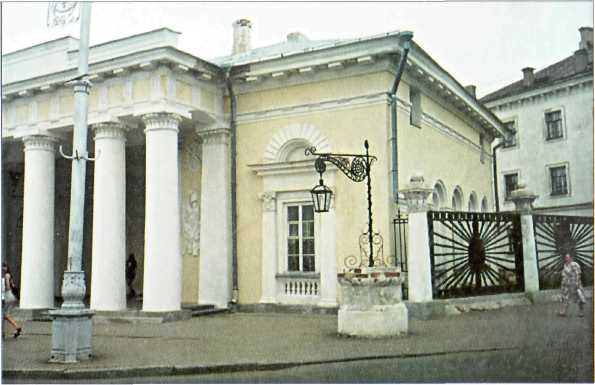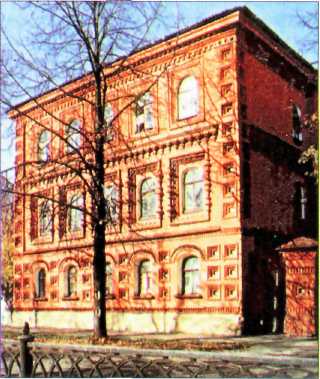
- •Architecture
- •11Th - 12th century. The growth of towns
- •13Th to 14th century. Mongol-tartar overlordship
- •15Th -16th century. The moscow architectural school
- •Monastery building
- •17Th century. The golden age of mediaeval russia
- •18Th – 19th century. New town-planning ideas
- •19Th to early 20th century. Historism. Art nouveau. Avant garde
- •The mediaeval Russian church
- •Mediaeval russian icon- and fresco-painting
- •The interior of a russian church.
- •Iconostasis.
- •The technique of icon-painting
- •Fresco-painting
- •Mediaeval russian sculpture
19Th to early 20th century. Historism. Art nouveau. Avant garde
Guard House Kostroma, 1820s. Architect P.I. Fursov
|
The second half of the 19th and beginning of the 20th century was also a time of intensive building in Yaroslavl, Ivanovo, Vladimir, Kostroma and Shuya. This was the area where many important events of the industrial revolution of the 19th century took place. Large factories and plants were built in the suburbs, often with very interesting architecture, sometimes "Gothic" in the English style, sometimes closer to rationalist constructivism The owners of these industrial enterprises, merchants and bankers, bought old estates in prestigious parts of the town and rebuilt them in accordance with the style of the day. |
Pochtovaya 4, Yaroslavl. Early 20th century
|
The prevailing fashion was for "historical styles". In Ivanovo and Yaroslavl you can see fine mansions of the late 19th century in neo-Renaissance, neo-Baroque or what were then extravagant houses in art nouveau. The building of such mansions continued right up to the revolution of 1917. After the Bolsheviks came to power, during the Civil War and particularly during the fierce struggle against religion, historical monuments in the towns of the Golden Ring suffered badly. Many churches were blown up or used as storehouses and monasteries were turned into prisons or simply closed down and abandoned. Mansions were split up into "communal flats". At the same time Soviet architects continued to design some very interesting buildings that expressed the ideas of avant-garde art. Of all the towns in the Golden Ring, Ivanovo has the most interesting specimens of Russian avant-garde architecture In the mid-1930s, however, the avant-garde was forbidden and "Soviet classicism» became the official style of the Stalinist empire. |
The mediaeval Russian church
Mediaeval Russian churches are based on the Byzantine model They have four pillars that support the vaulting and form a cross in ground plan The apse consists of three semicircular protruding sections that traditionally face east It can only be seen from the outside, because inside it is cut off from the main body of the church by a high iconostasis Behind the iconostasis is the sanctuary with the altar The three sections of the apse symbolise the holy Trinity. The main entrance is through the west door. There are also doors in the south and north walls with portals richly decorated with stone carving or twisted columns On the outside the walls are divided into three (or more) sections by flat pilaster strips Mediaeval churches could have one, three or five domes Later on bell-towers were added and connected to the church by a porch The main body of the church was surrounded by covered galleries, a feature particularly widespread in the 17th century
DIAGRAM OF A RUSSIAN CHURCH
|
|



